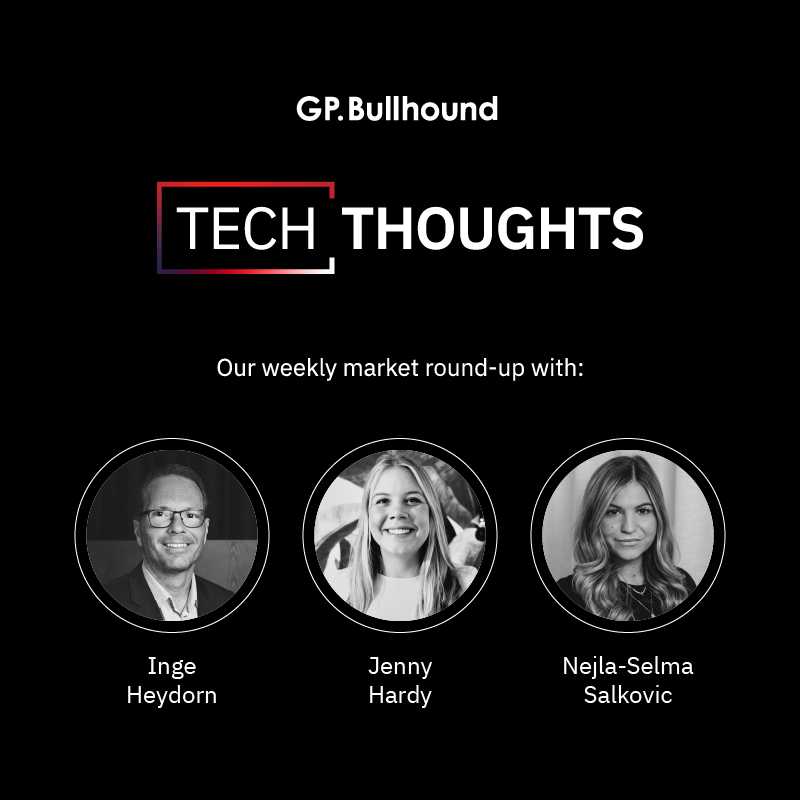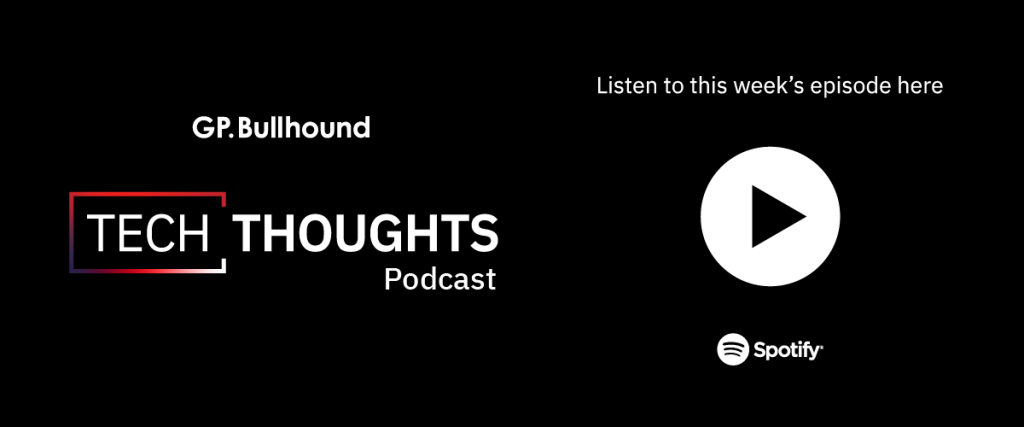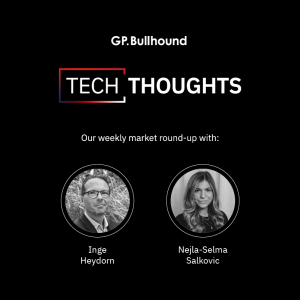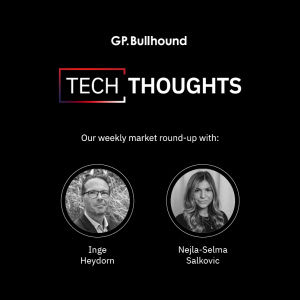Tech Thoughts Newsletter – 26 May 2023.

There is only one thing to talk about in tech and in our portfolio this week, and that’s Nvidia’s extraordinary guidance. The $11bn Q2 guide compares to $7.2bn Q1 revenues (which itself beat guidance by 10%) and Q2 consensus of $7.2bn.
It’s huge, will be by far the biggest revenue quarter for Nvidia, and it’s all down to data centre revenue, specifically AI GPUs for both training and inference (both of Nvidia’s A100 and H100 products).
It shows beyond doubt that the AI spend race has begun, with hyperscalers building out AI capacity and enterprises looking to deploy AI into their businesses. Nvidia’s call featured an impressive roster of companies deploying AI with Nvidia – AT&T, Amgen, ServiceNow – the clear message was that this is technology adoption is widespread, AI’s “iPhone moment” is upon us, and this really is a new normal.
It’s hard to convey what an extraordinary number this is. Partly because this isn’t software or internet – Nvidia have to actually sell and ship $4bn more physical chips than they did this quarter. And crucially – TSMC needs to make them!
Nvidia’s H100 “Hopper” product is made at TSMC’s 5nm node, and its A100 “Ampere” is made at its 7nm node.
When TSMC reported back in April, we had slightly wondered what had made them so confident in the second half recovery. But Nvidia volume looks now to be the answer – Nvidia stated they have secured materially more supply in H2 vs H1 (both the Ampere products are built at TSMC and this is going to be very helpful for TSMC’s guided second half recovery too), which implies this demand is more than sustainable. We think there’s also a lot of positive price mix with the H100 materially higher ASP than the prior model.
The next question on everyone’s minds is how long the current level of high demand can sustain. Huang did a pretty decent job on the call of describing AI’s “iPhone moment”:
“And what happened is, when generative AI came along, it triggered a killer app for this computing platform that’s been in preparation for some time. And so, now we see ourselves in two simultaneous transitions. The world’s $1 trillion data center is nearly populated entirely by CPUs today, and $1 trillion, $250 billion a year, it’s growing of course. But over the last four years, call it a $1 trillion worth of infrastructure installed. And it’s all completely based on CPUs and dumb NICs. It’s basically unaccelerated.
In the future, it’s fairly clear now with this — with generative AI becoming the primary workload of most of the world’s data centers generating information, it is very clear now that — and the fact that accelerated computing is so energy efficient, that the budget of the data center will shift very dramatically towards accelerated computing and you’re seeing that now. We’re going through that moment right now as we speak. While the world’s data center CapEx budget is limited but at the same time we’re seeing incredible orders to retool the world’s data centers.
And so I think you’re starting — you’re seeing the beginning of call it a 10-year transition to basically recycle or reclaim the world’s data centers and build it out as accelerated computing. You’ll have a pretty dramatic shift in the spend of the data center from traditional computing, and to accelerated computing with smart NICs, smart switches, of course, GPUs, and the workload is going to be predominantly generative AI.”
So $1trn of infrastructure that needs to shift to accelerated compute (to GPUs, to faster CPUs, to lower latency higher throughput networking equipment). And that is all infrastructure that will need to go through a continued refresh cycle over the next several decades, as more data gets processed, to keep pace with the latest and most efficient chips.
This is a multi year, multi decade transition, and certainly not a one off quarter – or year.
We had some incoming questions around valuation. We’ve never argued for Nvidia being “cheap”. But in P/E terms, we should note that Nvidia got cheaper this week. We think the $4.60 consensus earnings this year should go above $8 (so 60% higher vs the ~25% stock move), given the revenue and margin drop through around the H100 product. That puts Nvidia on <50x P/E this year. It’s expensive, but if we think about that multi year infrastructure shift to accelerated compute, and how much of that needs to shift to Nvidia over time, and Nvidia’s competitive moat around its CUDA software layer, it becomes easier to frame, and it remains a core holding in our portfolio.
What does it mean for the rest of the tech? Nvidia’s position as the leader in GPU is clear, but this will also benefit players across the AI value chain – from the CPU providers (we own AMD), TSMC (who make both Nvidia and AMD chips) – both AMD and TSMC shares were up double-digit on Thursday, the networking infrastructure players (we own Cisco), and the semicap equipment makers (ASML, Applied Materials, KLA, LAM Research)
Onto broader newsflow:
Palo Alto continues to execute as the platform play in cyber
- Palo Alto (owned) reported another solid set of results and a guidance raise – Q3 billings growth of +26% yr/yr beat consensus (+24%) – no slowdown from the strong prior quarter
- Full year billings growth guidance is now at 23-24% from 22-23%, and they’re raising profitability guidance by another 100bps. It means operating margins will be higher than 23% this year, with continued leverage in the years ahead.
- We know cyber demand is holding up solidly across the board – we’ve seen this from Fortinet earlier this month, ZScaler positive profit warning too
- But what makes Palo Alto stand out is in growing completely new products and new markets. Their next gen security (NGS) business is a $2.6bn/quarter business (which isn’t much more than 3 years old), still growing 60% yr/yr..
- Within that XSIAM (which was launched not much more than a year ago – and is now being helpfully positioned alongside AI workloads) is seeing 8-figure deals being signed (and they don’t sell it without their core product alongside it) – it will probably be the fastest ramp of any NGS product. It’s an example of what they keep doing so well – adding to the product set and expanding their market.
- They are a beneficiary of spend consolidation – with we think the strongest cross product security portfolio at a time where customers are looking to consolidate spend.
- The negatives were around comments that the deal scrutiny/deal lengthening they’re seeing is becoming “more widespread” with the weaker macro.
Portfolio view: Palo Alto is a core holding for us in software: This is a business in one of the strongest structural spend tailwinds in software (cyber), executing on product expansion and sales, and showing real margin leverage.
Incumbent software continues to deliver – though more margin/cost cutting upside than revenue right now
- Workday (owned) Q1 came in a bit better than the guide and expectations – subs revenue growth of 20.1% yr/yr beat cons of 19.5%. Better revenue flowed through to the bottom line and non GAAP op margin 23.5%, an impressive 200bps ahead of cons of 21.6%.
- The key 24 month backlog (cRPO) growth accelerated to 22.9% from 21.3% yr/yr last quarter (vs cons 20.5%). They are raising the lower end of the FY24 guide so the prior midpoint (18% yr/yr subs growth) now representing a lower bound, margin guidance maintained at 23% (firmly on track for the 25% mid term).
- Q2 subs guidance is for 18% growth – in line with cons and cRPO expected to grow 20% in Q2.
Portfolio view: Workday isn’t perhaps the most exciting of software businesses right now, but it continues to execute as a de facto standard in HR software, driving continued expansion of its platform. There had been a degree of nervousness around channel checks, which this set of results rebuffs (and there was clearly a degree of relief with shares +8% after hours)
HR software may not be as exciting as AI right now, but there’s upside in margin (as with the broader software space) which we think can continue to drive compounding value, with relatively low downside risk.
Mixed datapoints in auto and industrial
- Analog Devices (owned, small position) reported a beat for the April quarter results, but a bit of a damp guide for the July quarter.
- The main takeaway was a softer China, in both industrial and auto, as the recovery expected after the COVID restrictions lifted hasn’t come through, and both are expected to decline low-mid single digits sequentially – not a disaster, but not the strength we’ve seen elsewhere in the sector
- ADI is less exposed to the content increases in the power train vs Infineon, so benefits less from that content increase in the move to EV.
Portfolio view: we still like exposure to the shift to EV and the semi content growth (in our numbers, the number of cars sold car stay the same over the next 10 years, and the semi conductor content will double as a result of increasing EV penetration.
The comments around China reflect more broadly some questionmarks around the economy there. Xiaomi reported a 19% decline in revenues and spoke of “uncertainty in the global economy” when probably what it wanted to say was “Chinese economy”... We try to limit our exposure to consumer semis, because so much of that market does depend on a Chinese recovery in demand that keeps getting pushed out.
AI demand fuelling networking infrastructure upgrades
- Marvell (not owned) reported a solid set of results but more important was its commentary around its AI-related demand.
- Marvell is focused on chips for connectivity across data centres.
- makes (alongside other chipsets) DSPs (Digital Signal Processors), which takes inputs from the switch ASICs, converts them from analog to digital and performs operations like signal conditioning, equalisation, error correction, converts those back to analog and pushes them forward.
- With the scale of data and bandwidth required in AI processing and AI clusters, that requires much higher optics performance, which is driving demand for Marvell’s PAM4 DSP platform (a lot of this directly sitting alongside Nvidia’s H100 and A100 infrastructure).
- Key was that Marvell indicated that it was on track to doubling its AI-based revenue to $400m in 2023 from demand pull in on its DSP chipsets, and then doubling again to 2024.
- Marvell has an additional opportunity around custom silicon (ASICs) as compute engines in AI infrastructure, alongside GPUs.
Portfolio view: we don’t own Marvell, but we do recognise that networking infrastructure (we spoke last week about Cisco) is a slightly forgotten beneficiary of AI – the bandwidth and performance required, as well as a likely faster refresh rate of technology.
Cloud consumption still seeing optimisation headwinds
- It feels strange to be reporting headwinds in cloud but we should acknowledge that actually outside of AI, we have seen continued headwinds around cloud and datacentre, related to the weaker macro
- Snowflake (not owned) reported ok results but guided revenue growth down (again) for the full year.
- They pointed to optimisation from existing customers holding back spend, a trend which deteriorated in April, and newer cohorts taking longer to ramp up consumption.
Portfolio View: These cloud consumption business models still haven’t really been through a cycle. It now looks like the boom 2020/2021 period was really overspend and we’re now in period of consolidation that’s even more pronounced than the more “traditional” SaaS-type models. We continue to be cautious and currently don’t have any exposure in the portfolio.

For weekly insights on the latest market updates, please subscribe to our Tech Thoughts podcast.
For more information about the latest trends and forecasts, please visit our official Tech Thoughts page.
We provide investors with access to category leading technology companies, globally. Our assets under management have a total value of more than $1bn, and our limited partners include institutions, family offices and entrepreneurs. Learn more about our funds here.
Enquiries
For enquiries, please contact:
Inge Heydorn, Partner, at inge.heydorn@gpbullhound.com
Jenny Hardy, Portfolio Manager, at jenny.hardy@gpbullhound.com
Nejla-Selma Salkovic, Analyst, at nejla-selma.salkovic@gpbullhound.com
About GP Bullhound
GP Bullhound is a leading technology advisory and investment firm, providing transaction advice and capital to the world’s best entrepreneurs and founders. Founded in 1999 in London and Menlo Park, the firm today has 13 offices spanning Europe, the US and Asia. For more information, please visit www.gpbullhound.com.

